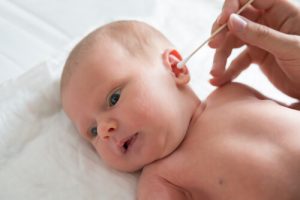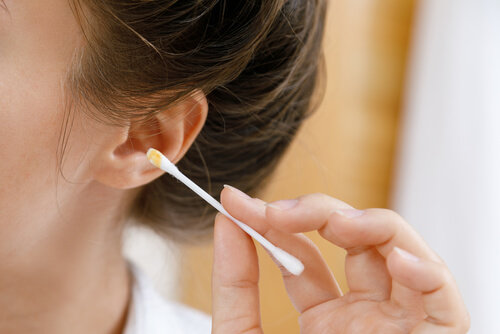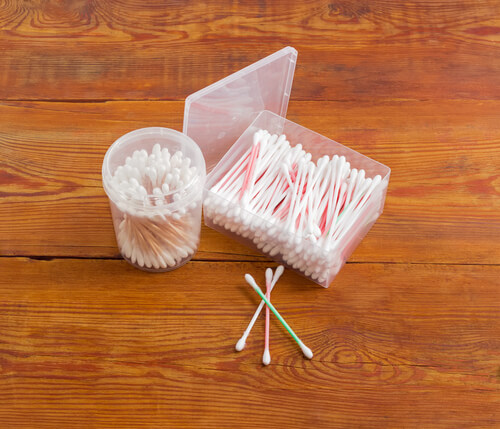How to Clean a Child's Ears

Wax is a protective substance, but when present in excessive amounts, it causes plugs that are very annoying. Therefore, learning to clean a child’s ears is an important but very simple task.
The ear is divided into three parts. The external part includes the auditory or auricular pavilion. It connects through the ear canal, which reaches the eardrum in the middle ear and then passes to the inner ear.
In the skin of the ear canal, there are special glands that produce wax, or cerumen as it is technically known. This substance slowly reaches the opening of the outer ear, where it comes out or falls out during a bath.
How to clean a child’s ears
When the body itself does not expel earwax, this yellowish, sticky substance accumulates and can clog the ear canal. The consequences are diminished hearing, vertigo or motion sickness.
A newborn is unlikely to have dirty ears. A superficial cleaning will be enough. But over time, it is important to learn how to clean a child‘s ears in order to avoid mistakes. Being obsessive can affect the child’s health.
Cleaning a child’s ears involves doing so from the outside of the ear canal.
During bath time, with a cloth or wet wipe, you can remove the wax that is seen in the external areas.
No type of object should be inserted into the ear. If you believe there is a lot of wax inside the ear, you should consult your pediatrician. This expert will evaluate whether there is a plug and rule out other possible problems.
When objects such as cotton swabs are introduced into the ear, there is a risk of pushing wax remnants inside the ear and creating a plug.

The danger of damaging the eardrum is high. If the baby makes an unexpected movement during deep cleaning, the consequences can be serious. If the object is also sharp, like a toothpick or hairpin, the damage will be even greater.
Because it is a very thin conduit in children, inserting objects in the ear can cause the outer layer of skin to be scraped off. As a defense mechanism, wax production is increased, which could become a problem.
How to reach inside?
The accumulation of wax in the ear can be resolved in several ways, none of which are traumatic or risky.
One way to clean a child’s ears is to use mineral oil, olive oil or glycerin. Two or three drops will soften the wax and allow it to easily exit the ear. It is also recommended to apply two or three drops of warm paraffin oil.
To clean the ear, you can dissolve a teaspoon of salt in a half cup of water. Place a few drops in the ear, let it sit and then tilt the head to drain the solution.
Another recommendation is to heat oxygenated water or make an infusion of chamomile. Place the warm drops in the ear and wait for the wax to begin to drain.
If the wax still does not come out, or if the ear becomes painful, it will be necessary to consult your doctor.

Bathing and cleaning a child’s ears
You must take advantage of bath time to check the consistency and color of your child’s ear wax. It must be fine, light yellow or nearly orange. If it becomes thick and dark, you must schedule a visit to the pediatrician to rule out any problem.
Swabs are useful for cleaning the external parts of the ear, as are cloths damp with soapy water. In both cases, you should try to hold the baby’s head to the side and move from the inside out.
If water falls into the child’s ears during a bath, it is necessary to tilt the head in both directions in order to remove it. That action, plus drying with a towel, will suffice.
It is recommended to take necessary precautions to prevent water from falling inside the ear canal.
If there is still water inside the ear, you should trust the small hairs in the area. They will prevent the liquid from entering the middle or inner ear.
In newborns, cleaning the ear is not a routine task. As the months go by, more frequent hygiene will become necessary, and parents will learn to perform it until the child knows how to clean his ears by himself.
Wax is a protective substance, but when present in excessive amounts, it causes plugs that are very annoying. Therefore, learning to clean a child’s ears is an important but very simple task.
The ear is divided into three parts. The external part includes the auditory or auricular pavilion. It connects through the ear canal, which reaches the eardrum in the middle ear and then passes to the inner ear.
In the skin of the ear canal, there are special glands that produce wax, or cerumen as it is technically known. This substance slowly reaches the opening of the outer ear, where it comes out or falls out during a bath.
How to clean a child’s ears
When the body itself does not expel earwax, this yellowish, sticky substance accumulates and can clog the ear canal. The consequences are diminished hearing, vertigo or motion sickness.
A newborn is unlikely to have dirty ears. A superficial cleaning will be enough. But over time, it is important to learn how to clean a child‘s ears in order to avoid mistakes. Being obsessive can affect the child’s health.
Cleaning a child’s ears involves doing so from the outside of the ear canal.
During bath time, with a cloth or wet wipe, you can remove the wax that is seen in the external areas.
No type of object should be inserted into the ear. If you believe there is a lot of wax inside the ear, you should consult your pediatrician. This expert will evaluate whether there is a plug and rule out other possible problems.
When objects such as cotton swabs are introduced into the ear, there is a risk of pushing wax remnants inside the ear and creating a plug.

The danger of damaging the eardrum is high. If the baby makes an unexpected movement during deep cleaning, the consequences can be serious. If the object is also sharp, like a toothpick or hairpin, the damage will be even greater.
Because it is a very thin conduit in children, inserting objects in the ear can cause the outer layer of skin to be scraped off. As a defense mechanism, wax production is increased, which could become a problem.
How to reach inside?
The accumulation of wax in the ear can be resolved in several ways, none of which are traumatic or risky.
One way to clean a child’s ears is to use mineral oil, olive oil or glycerin. Two or three drops will soften the wax and allow it to easily exit the ear. It is also recommended to apply two or three drops of warm paraffin oil.
To clean the ear, you can dissolve a teaspoon of salt in a half cup of water. Place a few drops in the ear, let it sit and then tilt the head to drain the solution.
Another recommendation is to heat oxygenated water or make an infusion of chamomile. Place the warm drops in the ear and wait for the wax to begin to drain.
If the wax still does not come out, or if the ear becomes painful, it will be necessary to consult your doctor.

Bathing and cleaning a child’s ears
You must take advantage of bath time to check the consistency and color of your child’s ear wax. It must be fine, light yellow or nearly orange. If it becomes thick and dark, you must schedule a visit to the pediatrician to rule out any problem.
Swabs are useful for cleaning the external parts of the ear, as are cloths damp with soapy water. In both cases, you should try to hold the baby’s head to the side and move from the inside out.
If water falls into the child’s ears during a bath, it is necessary to tilt the head in both directions in order to remove it. That action, plus drying with a towel, will suffice.
It is recommended to take necessary precautions to prevent water from falling inside the ear canal.
If there is still water inside the ear, you should trust the small hairs in the area. They will prevent the liquid from entering the middle or inner ear.
In newborns, cleaning the ear is not a routine task. As the months go by, more frequent hygiene will become necessary, and parents will learn to perform it until the child knows how to clean his ears by himself.
This text is provided for informational purposes only and does not replace consultation with a professional. If in doubt, consult your specialist.








